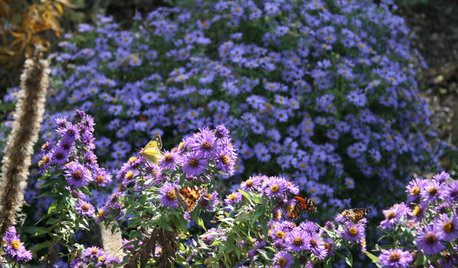ginger for pipevine swallowtails?
christie_sw_mo
14 years ago
Related Stories

GARDENING FOR BUTTERFLIESButterfly Gardening: Delight the Eyes With Living Sculptures
Surprise and thrill with a garden that attracts magical winged creatures, bringing color, movement and life
Full Story
GARDENING GUIDESGarden-Friendly Native Alternatives to Overplanted Exotics
There are lots of gorgeous, wildlife-friendly native plants ready to make an appearance in your garden
Full Story
FLOWERS15 Native Flowers That Attract Butterflies
By picking plants from this list that are right for your location, you’ll get colorful blooms and support pretty pollinators
Full Story
EDIBLE GARDENS12 Essential Herbs for Your Edible Garden
Make home cooking and drinks even better with herbs plucked from your own backyard or windowsill pot
Full Story
GARDENING FOR BUTTERFLIESGardening for the Bees, and Why It’s a Good Thing
When you discover how hard bees work for our food supply, you may never garden without them in mind again
Full Story
FALL GARDENING7 Reasons Not to Clean Up Your Fall Garden
Before you pluck and rake, consider wildlife, the health of your plants and your own right to relax
Full Story
GARDENING GUIDESSoutheast Gardener's May Checklist
Bask in the blooms and mind your mulch this month; summer means lots to savor and lots to do in the garden
Full Story
GARDENING GUIDESGreat Design Plant: Amelanchier Signals Spring With Airy White Blooms
With roughly 20 species of serviceberry native to the U.S., bees can feed on the early-season blooms while birds enjoy the summer berries
Full Story


butterflyman
bananasinohio
Related Professionals
Galt Landscape Contractors · Shoreview Landscape Contractors · Suitland Landscape Contractors · Wailuku Landscape Contractors · Wheat Ridge Landscape Contractors · Kingsburg Landscape Contractors · Goldenrod Landscape Contractors · Maple Heights Landscape Contractors · Fremont Fence Contractors · Marana Fence Contractors · Pacifica Fence Contractors · Wilmington Window Contractors · Bloomington Window Contractors · Homestead Window Contractors · Sebring Window Contractorsmurray_2008
bananasinohio
jrcagle
bananasinohio
loess_roots
cecropia
jrcagle
KC Clark - Zone 2012-6a OH
bananasinohio
KC Clark - Zone 2012-6a OH
loess_roots
KC Clark - Zone 2012-6a OH
butterflymomok
susanlynne48
Tess_in_Indy
KC Clark - Zone 2012-6a OH
jeanner
bigthicketgardens
KC Clark - Zone 2012-6a OH
KC Clark - Zone 2012-6a OH
bananasinohio